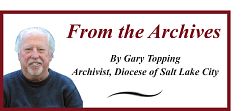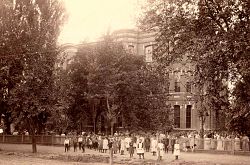Utah's Catholic Schools Began With Saint Mary Academy
Friday, Jan. 13, 2017
As we prepare to celebrate Catholic Schools Day on Jan. 20, a brief look at our history shows that education has been a fundamental element in our ministries almost since the beginning of a permanent Catholic presence in Utah.
It is apparent that when Father Lawrence Scanlan (later the first Bishop of Salt Lake) took over the church of St. Mary Magdalen in Salt Lake City on Sept. 15, 1873, he already had in mind the establishment of a Catholic school system.
In view of the other projects he was faced with, like the creation of parishes and missions throughout the far-flung territory, and despite his gargantuan energy, it was obvious he was going to need help with the schools. Early the following year, he requested, and was granted, sisters from the Congregation of the Holy Cross, two of whom – Mother M. Augusta and Sister M. Raymond – arrived in 1875 to undertake the project.
Not content to await construction of their finished facility, the two sisters opened St. Mary’s Academy in a small adobe cottage on the present site of the Salt Palace on Sept. 6, 1875, patiently holding classes among the din and the dust as carpenters and plasterers completed the building around them.
Although the basic structure was finished the following spring, the sisters continued to purchase adjoining property and to expand into an amazing compound, including a heat plant, music hall, dormitories, kitchen, classrooms and infirmary, as well as a separate St. Joseph’s school for boys.
Despite the limited Catholic population, the school boasted a student body of some 200 by 1880. The high incidence of non-Catholic students in Catholic schools (roughly 40 percent) was a function of the lack of a public school system in Utah until the 1890s and the uneven quality of the Mormon ward schools. Several Protestant schools flourished throughout the territory for the same reasons.
And what a school St. Mary’s Academy turned out to be! Within a few years the faculty had grown from the original two to an average of 14 plus two music instructors, with most of the faculty members covering more than one subject.
Typical of Catholic schools even today, the school featured a no-frills curriculum based on the liberal arts and sciences and languages. Instruction fell into three main tracks: Primary, which was basically the three R’s; Preparatory, which added history, physiology and languages; and Academic, which added higher mathematics, chemistry, botany and geology, specialized history courses, philosophy and logic.
Elective music instruction in voice and various instruments was probably more extensive than in typical Catholic or even public schools of the day. Much of this curricular expansion, which included an emphasis on physical education as well, was the work of Mother M. Charles, who took over as Superior in 1878.
Like Catholic schools today, an education at St. Mary’s was not inexpensive: Resident students paid $125 for a five-month session, including board and room, with extra fees for instruction in music and languages (tuition and fees at Brigham Young Academy, which opened only a year after St. Mary’s, were a mere fraction of that). But Mother Charles provided various full and partial tuition waivers for the worthy poor and even arranged for graduates to repay tuition after they had found employment.
St. Mary’s Academy became a victim of its own success. Despite competition from the public school system during the 1890s and early 20th century, St. Mary’s continued to expand to a point at which even the enlarged facilities in downtown Salt Lake City could not contain it. Exploration during the early 1920s led to purchase by the Holy Cross sisters of a 400-acre tract in the Wasatch foothills at the eastern end of Thirteenth South and construction of an even more magnificent institution, St. Mary of the Wasatch, which opened in 1926.
Today, with three high schools, 13 elementary and middle schools, and five pre-schools in our diocese, we can be proud that we have continued the vision of Catholic education first caught by Fr. Scanlan and the Holy Cross sisters.
Happy Catholic Schools Day!
Gary Topping is the archivist for the Diocese of Salt Lake City.
For questions, comments or to report inaccuracies on the website, please CLICK HERE.
© Copyright 2025 The Diocese of Salt Lake City. All rights reserved.
© Copyright 2025 The Diocese of Salt Lake City. All rights reserved.



Stay Connected With Us